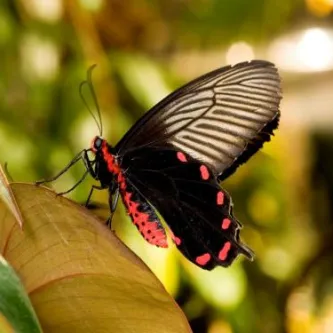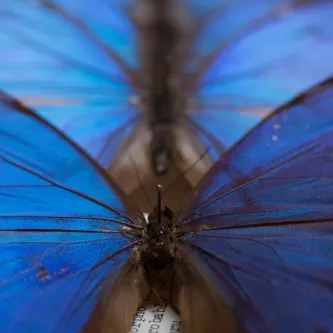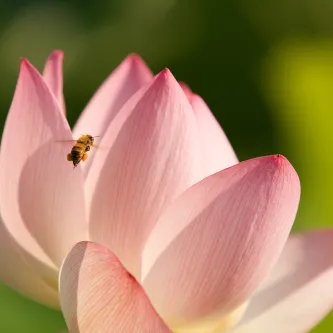Search
Butterflies and Beyond
Beyond Their Beauty
From the beauty of brilliant colors and intricate patterns to the phenomenal migrations of monarchs, butterflies are the subject of wonder and admiration. But that’s not all.
The Smithsonian Institution’s National Museum of Natural History houses a remarkable collection of about 35 million insect specimens including 3 million Lepidoptera (butterflies and moths) that are used for education and research. Scientists, educators, animal keepers, and volunteers collaborate to share knowledge and show the importance of these and other insects.
The live Butterfly Pavilion in the Butterflies + Plants: Partners in Evolution exhibition is a place where visitors can have interactive experiences with tropical butterflies and develop a better understanding of the roles butterflies play in the natural world.
Short Lifespans
The topic of lifespan comes up more than any other in the Butterfly Pavilion. All butterflies and moths have a larval stage and then undergo complete metamorphosis, emerging from pupa after transforming into adults. Their adult forms are radically different from the larvae. With a short adult lifespan (just 3 to 4 weeks), they are specialized for feeding and reproducing in a hurry.
Butterflies mate and the females oviposit (lay eggs), which passes on their genes to the next generation. This process has been at work for the last 48 million years for butterflies and 170 million years for moths.
Even Shorter Lifespans
Some species of moths called giant silk moths (Saturniidae family), such as the luna moth (Actias luna), atlas moth (Attacus atlas), and African moon moth (Argema mimosae), live only 4 or 5 days as adults. They don’t have any working mouthparts and cannot eat. Reproduction is their main focus — to successfully produce offspring.
However, giant silk moths have a long caterpillar (larval) stage. For example, the atlas moth can live up to 12 weeks as a caterpillar and grow to 3.5 inches long, whereas most butterfly caterpillars average only 10 days and 2 inches before pupating. Regardless, larvae consume a lot of species-specific plant leaves during this stage. Atlas moths prefer the leaves of citrus trees and other evergreens, including cinnamon.
Moth vs. Butterfly
Moths and butterflies are in the order Lepidoptera, deriving from the Greek words for “scale” and “wing.” The approximately 135,000 moth species and almost 20,000 butterfly species worldwide all have tiny scales on their wings.
Butterflies evolved from moths, so it may be easier to think of butterflies as specialized day-flying moths. Moths typically have feathery antennae that taper from a wider base to a pointed end, whereas butterflies have wiry antennae with a knob-like or truncated end. Since moths are primarily nocturnal insects, these feathered chemical receptors help them navigate and find mates at night.
Butterflies Can’t Do It Alone
Moths and butterflies rely on plants throughout their lives. Butterflies lay their eggs on specific host plants, such as milkweed for the monarch. When the caterpillars hatch, they thrive on the host plant's leaves, growing and growing until the caterpillar forms its cocoon or chrysalis, which is often attached to the plant.
When the new butterfly emerges as an adult, it travels from plant to plant to feed on flower nectar. As they collect nectar, their bodies trap pollen, which is passed on to other flowers they visit. The butterflies get the nectar they need, and the plants are pollinated, an excellent partnership. The coevolution of butterflies and plants in a feeding-pollination relationship has been going on for millions of years.
Butterflies in Agriculture
At the Natural History Museum, butterflies are the subject of research on pollination and biological control that is critical to agriculture. Entomologists affiliated with the U.S. Department of Agriculture, such as Dr. M. Alma Solis, conduct research to understand how populations of Lepidoptera are associated with agricultural fields. Experience their work by following a butterfly in a farm field or garden to see how many plants it visits and record its activity.
Butterfly Collections
The collections in the Department of Entomology at Smithsonian are used for research, such as on evolutionary relationships and ecology. A current focus is documenting the Lepidoptera of South America, “the richest and most poorly known fauna in the world.” For example, Dr. Bob Robbins uses the museum collections to sort out the relationships of species from Central and South America. In the last decade he has named 27 new species.
Advances in techniques to analyze DNA have allowed Smithsonian entomologists to deepen their study of Lepidoptera. While wing shape and other visible characteristics of butterflies may be indicators of their relatedness, DNA evidence is now widely used to determine ancestry.
Butterfly Conservation
The more aware we are of butterflies and moths and their habitats and needs, the better chance they have for survival. Data collected on butterfly populations helps define their conservation status and necessary conservation actions.
For example, Smithsonian’s Dr. Scott Miller conducts research on tropical biodiversity. He considers how populations of butterflies and other tropical species respond to impacts such deforestation, invasive species, and climate change. These impacts, coupled with others such pesticide use, are affecting populations of butterflies. The number of monarchs making their annual, phenomenal migrations has declined over the past decade.
How You Can Help
Scientists and educators at the Museum hope that visitors take not only an interest in these fascinating and beautiful creatures, but also an active role in their conservation.
Grow your own butterfly (or pollinator) garden by planting host and nectar plants in your backyard or schoolyard (milkweed, spicebush, sweet gum, depending on your climate zone). Identify trees around your area (use field guides or the Leafsnap app) to determine whether they may be hosts to giant silk moths. Consider joining monarch tagging projects or joining entomological and conservation societies and organizations. Enjoy getting more involved in your Lepidoptera community!
This article was updated December 16, 2024.


